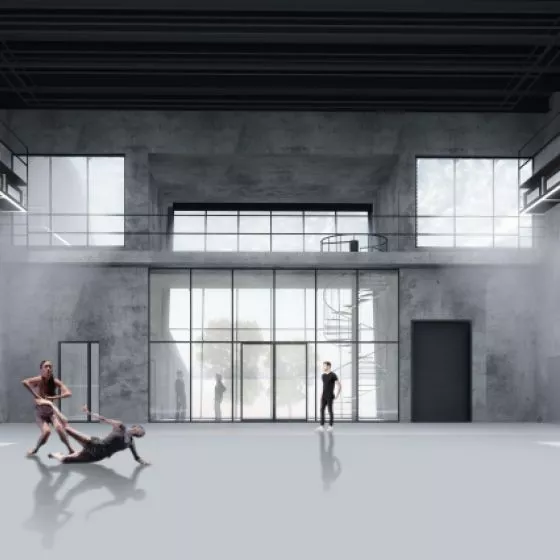Architects from the k3xmore studio, Kinga Kwaśny and Magda Orzeł-Rurańska, designed a small holiday home near Warsaw - House with a tree. The dark, monolithic block sunk in the forest landscape tenderly "wraps" one of the surrounding trees, and through irregular openings in the facades invites atmospheric green frames into the interior.



view from the entrance area
© k3xmore
Ola Kloc: What was the priority for investors?
Kinga Kwaśny, Magda Orzeł-Rurańska: Definitely as much contact with nature as possible. The plot is located in the immediate vicinity of a dense coniferous forest and this, for the investors, was its greatest value. Their main wish was to locate the zone where they would spend the most time in such a way that they would have the impression of being constantly among the trees. Therefore, the living area, library and bedroom were elevated to the level of the second floor, which not only increased the view and sense of intimacy for the users, but also heightened the impression of living at treetop level. The entire house was peppered with window openings so that a view - a frame of the forest - is available from every room.



library on the first floor
© k3xmore
Ola: What is the shape of the block and what influenced the choice of the dark facade of the house?
Kinga, Magda: The shape of the building is a combination of the eternal dreams of investors to spend time among nature with the pragmatism of the location and the proportion of leisure functions to auxiliary functions - kitchen, garage, utility rooms. The smaller part housing the living with a mezzanine for sleeping, topped by a gabled symmetrical roof, was located on the first floor. The first floor was occupied by the larger part - the kitchen with fireplace, built-in garage, and utility rooms (bike storage, heat pump room).
{The shape of the body of the building; connecting zones by lowering the eaves of the front elevation,title=the shape of the body of the building; connecting zones by lowering the eaves of the front elevation}
shape of the body of the building; connection of zones by lowering the eaves of the front elevation
© k3xmore
The two masses were connected by an eave, the height of which on the side of the front elevation could not exceed 4.5 meters, according to the decision on building conditions. We treated the masses as a monolith of one material - both the roof and the elevations are finished with flat ceramic tiles. This is another design decision dictated by pragmatism - in the vicinity of trees, facades tend to get dirty - the dark color of the building better masks dirt, and the slippery surface of the tile allows the facade to be "cleaned" more quickly by rain.



view from the side of the neighboring plot
© k3xmore
Ola: The small, black block "embraces" one of the trees growing on the plot - the trunk goes through the terrace and balcony on the first floor. What design decisions were influenced by your concern for the existing tree? Was it a major challenge to include it in the design?
Kinga, Magda: The location of the building on the plot implies preserving as many trees as possible. One of them was "absorbed by the building" and this was a design decision that proved to be a difficult aspect at the stage of the construction project. This had the greatest impact on the foundation of the building and the protection of the foundation from roots. The building was designed in a frame structure with point foundations, so as to interfere with the ground as little as possible.



view from the living area, closed house
© k3xmore
Ola: Thank you for the interview.















































